Foundations of Being
Published in the Journal of the Craniosacral Therapy Association UK, The Fulcrum, Issue 68, May 2016.
Written By Terry L Collinson SRP, APAM, RCST, BCST
What a gift it is to be able to use our therapeutic skills to support sick, injured, and traumatised animals. There is much learning available within that gift which can educate us on the finer points of working with people.
It is the early morning of day two of the 12th of 13 seminars in the two-year BCST practitioner training in June 2015, and a cold winter in New South Wales, Australia. To support a deepening of the practical aspects of being in relationship from a biodynamic and resonant perspective we are heading out to spend a day at "Maggie's Farm, Wellness & Educational Sanctuary". Wellies, cold weather gear, waterproofs and a sumptuous lunch in tow we navigate everything from the M1 motorway to dirt roads, narrow, wobbly bridges and magnificent potholes. This sanctuary will provide a perfect environment to experience being in a therapeutic relationship with horses, dogs, goats, and one indomitable cat.
Along with students and graduates is my 11-year-old granddaughter Kara who loves animals and her BCST sessions. She solely volunteered to help with the logistics of the workshop.
Our intention for the day was to invite a depth of resonance with the animals and their specific needs and also to deepen our personal experience of how we are in a therapeutic relationship. Under the experienced guidance of Virginia Ede, who owns and runs the Sanctuary, we all agreed that the day underlined how a respectful, patient, and biodynamic approach is fundamental to being able to be in a truly therapeutic and healthy relationship with anyone -- human or animal.
The extra layer of challenge was potentially in the history of these "rescue" animals, who all had significant trauma and neglect in their background. Animals are straightforward in their needs and are clear in letting you know if your approach is acceptable and that you are 'doing' it right. These selfless animals also offered much learning and reflection of our approach to healing in a simple, straightforward, and observable way. What great learning -- and in just one day.
There were five standout learnings:
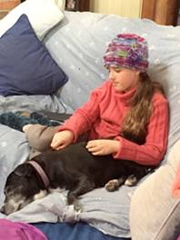
The Innocence of Being, Trust & Strong Boundaries
Kara was sitting quietly on the sofa with her Kindle as we returned to the homestead after being with the horses and goats. After lunch, following on from an overview of each dog's history, we settled in to build a relationship with the dogs. One student sat beside a black 'Staffie' called Chloe, uncertain of the right approach, taking time to settle into her 'rhythm of presence', and sensing where to make contact, Chloe noisily groaned moved over and settled into Kara's lap (see the photograph). Without training or suggestion, Kara became still and present offering Chloe space, empathetic focus, and ease of presence and contact. This 'session' lasted for some time until a more agile, flexible and very relaxed Chloe stretched and jumped off the sofa. The potency of being was evident and included a whole aura of presence, no pre-designed hand position, and no agenda!
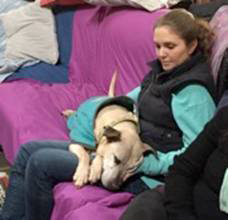
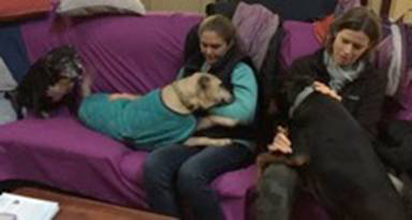
Sarah, pictured above on the left with Melody who had a very long session and often changed position to dictate the best hand contact. And Julie pictured above on the right, with an exuberant demanding Dooley who required strong boundaries, and with Chloe turning up again - all a familiar scenario for those who work with mobile infants and siblings. Virginia reminded us of the importance of the alpha dog/person of the pack or tribe and Dooley was certainly doing his best to take that position!
Empathy vs Sympathy
The brown Kelpie, Abbey, approached no one but waited shyly (don't look at me) for someone to sit down on the floor beside her for her session. Abbey's story is particularly harrowing, and this session highlighted how vital it is that the approach is one of empathy rather than sympathy, which was clearly unacceptable and unsafe.
Patience, Spacious Attention and Respect
Then there was "Bruce Almighty", a male goat who had recently undergone major life-saving surgery to bypass his urethra. Bruce, who lives with a young goat "Flirt", is normally very sociable with anyone, maybe hoping for extra interesting food and a scratch, but he was very suspicious of the group, probably wondering if there was an injection to come or some other painful procedure.
With a reminder about waiting for the animal to come to you ("wait for the patient to turn up" Rollin Becker) and within a lively Q&A session with Virginia, plus Flirt trying to take centre stage, the group's dynamic became still, spacious and patient. After much wariness and circling eventually Bruce singled out one student to nudge and say hello and be scratched, and he then engaged with more of the group. Bruce later recovered well from his surgery, and we surmised that this day marked the beginning of his return to health.
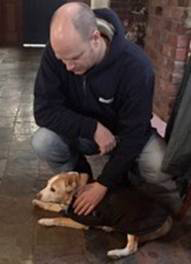
Pictured on the left is Anthony working with Maggie. She just sat at his feet and waited for him to pay attention. The 'patient' turned up. After the 'session' Maggie was more agile and in observably less pain.
Reciprocity of Healing
Working with the horses for a full morning, even in the heavy rain and cold, was the much-anticipated highlight of the day. The ever patient and very large Donahue began the morning by offering his muscular frame in a way that some nervous students became confident to approach and make contact. The reciprocity of healing was stunning. The morning session would have required a video to capture the significant learning through Donahue and the other many and varied horses.
The last notable "aha" was offered by one of Maggie's Farm cats, Jonesy.
Safety
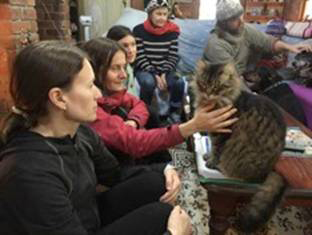
Jonesy seemed to require not only the "right" person but also a whole and perfect environment before hand contact was possible. For those who work with babies, children, and severely traumatised people this may sound familiar!
As Dan, in the background of the picture, worked with Dooley and Chloe, and other students settled into holding space, an environment was created where Jonesy decided to or felt safe enough to approach Marion. He received a long session, and my observation was that it was a privilege, both ways.
Those sweet biodynamic craniosacral therapy skills that we read much about and talk a lot about in the practitioner training all came together through the gentle yet firm demand from the animals of nothing less than perfect. The animals showed us our personal challenge of Being in relationship with their very individual presence and needs.
Two years of learning and practice came together on that one day, with a final "aha".
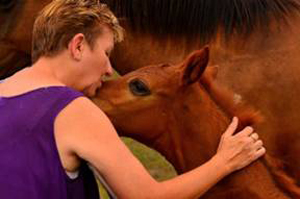
Virginia Ede (pictured left) is a qualified Natural Therapies practitioner with a passion for offering safety to traumatised and neglected animals and encouraging reciprocity, where the rescue animals in their own way offer humans healing. Virginia has a Diploma in Bowen Therapy and is qualified in Cat, Canine and Equine Muscle Release Therapy, Australian Bush Essences, Reiki, Intuitive Guidance, Equine Connections and Guidance, Animal Connections, and she offers Empowerment and Lifestyle workshops.
http://www.newsofthearea.com.au/rescued-horses-healing-humans-at-maggies-farm-near-bulahdelah-47468
About the Author: Terry Collinson is an Edinburgh-graduated Physiotherapist who trained with Franklyn Sills and Paul Vick in Craniosacral Therapy (CST) and graduated in 1996. She runs a busy Biodynamic Craniosacral Therapy practice in Sydney and from home in the beautiful Bays area in the Central Coast of NSW. Terry trained to teach the Biodynamic and Resonance approach to CST with Paul Vick and Resonance Trainings and now, with a passion for sharing the principles of this work she runs professional training, seminars, and workshops through Stillness Trainings in Australia and New Zealand.